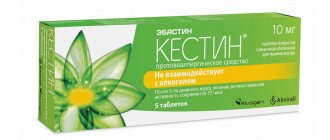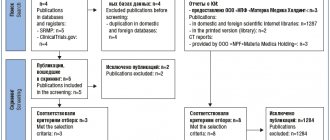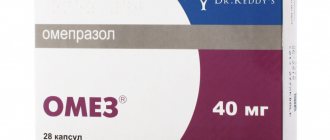Catalin is an effective drug for the treatment of cataracts
The review describes the epidemiological aspects of cataracts and the possibilities of its treatment. Particular importance is attached to the drug Catalin, which has an anti-cataract effect. Key words: cataract, anti-cataract drugs, Catalin. Abstract Catalin: effective eye drops for the treatment of senile cataract. Review Oganezova Zh.G., Egorov E.A.
RNIMU named after NI Pirogov Epidemiological aspects of cataract, methods of its treatment are described in the article. Particular attention is given to Catalin, which is characterized by its anticataract effect. Key words: cataract, anticataract effect
Cataracts are the main cause of decreased visual acuity and blindness in the population of most countries of the world. 20 million people suffer from blindness due to this disease [1, 2]. Cataract is a significant medical and social problem, but it can be solved, because the blindness resulting from this disease is reversible thanks to surgical treatment. In the vast majority of cases, age-related cataracts occur - a disease that develops in people over 50 years of age. The peak incidence occurs at 70–80 years of age. The formation of age-related cataracts is associated with the aging process of eye tissues, which undergo characteristic changes with age: the lens is deformed and loses its transparency, accommodation is impaired, dystrophic changes develop in the retina, and nutrition of the optic nerve deteriorates. These processes have a negative impact on visual acuity [3]. Age-related changes in the vascular tract of the eye lead to disruption of the regulation of the lens, its hydro- and hemodynamics. Normally, the state of transparency of the lens is ensured by the balance of the physicochemical state of its membrane proteins and lipids, the content of water and ions, and the removal of metabolic products. As cataract progresses, the amount of proteins in the lens decreases, protein-bound amino acids disappear, and metabolic acidosis develops. First, moderate hydration of the lens and a slight increase in its volume are observed, which is accompanied by an increase in refractive power. After 40 years, the so-called presbyopic age begins. During this period, due to a malnutrition of the lens and a slowdown in metabolism in its various layers, initial opacities may occur. Around the age of 60, as a result of phacosclerosis, the ability to accommodate is significantly reduced [4, 5].
The clinical picture of cataracts is based on the visual disturbance and is very diverse depending on the stage of the cataract. Initial cataract is characterized by clouding of the lens, which appears along the periphery - outside the optical zone, while the intensity of the clouding in different parts of the lens is not the same. Patients may complain of blurred vision, spots, or double vision of luminous objects. Initial cataracts may develop unnoticed and slowly. This stage of the disease lasts in different ways - from months to decades. The initial cataract may remain in one position for a long time, but sooner or later it progresses and enters the second stage of its development - this is an immature, or swelling, cataract. Immature cataracts develop with the progression of opacities in the central optical zone. This clouding of the lens leads to a noticeable decrease in visual acuity. When examining the eye, it is clear that the lens located in the pupil area is gray-white. The immature cataract stage can also last for quite a long time and gradually progresses to the next stage. Mature cataracts are caused by opacities of the entire area of the lens up to its anterior capsule. Gradually, visual acuity decreases to the level of light perception, and the lens becomes denser. Diffuse gray opacification is visible in the pupil area. If the lens is not removed, then mature cataracts gradually, over several years, move into the next stage. Overripe cataract is a further progression of the disease, accompanied by the disintegration of the lens, which acquires a uniform milky-white hue. The dense cortex of the lens gradually liquefies and turns into a milky mass in which the lens nucleus floats, changing its position with head movements. The lens shrinks, the anterior chamber deepens, and iris trembling (iridodonesis) appears. At this stage, object vision may reappear.
During the development of cataracts, severe and rapidly progressing complications may occur, the incidence of which is extremely low (0.03–0.06% of cases). Complications of cataracts include secondary phacogenic glaucoma, which occurs as an acute attack (occurs in the immature or overripe stage of cataracts), and rupture of the capsule of overripe cataracts, which provokes acute phacolytic iridocyclitis with hypertension syndrome. If these complications develop, patients require urgent surgical intervention. Age-related cataracts, depending on the location of the opacification, are divided into cortical, nuclear and posterior subcapsular (cup-shaped), which mainly manifests itself in the initial stages of the disease [6]. In the vast majority of cases, cortical cataract develops, in which the clouding is located, respectively, in the cortex of the lens, where water gaps are formed, dissociation of the cortex occurs, resulting from the accumulation of moisture in the extracellular space. Subsequently, opacification of the radial water gaps develops, and larger spoke-shaped opacities are formed. Nuclear cataracts are characterized by the formation of opacities on the nucleus of the lens. The process begins from within the core and gradually covers all its layers. The cortical layers of the lens do not become cloudy and remain transparent. The core material becomes denser and may acquire a brown or black color. With posterior subcapsular cataracts, grayish or brown opacities are located first in the posterior pole of the lens under the capsule in the form of a thin, even layer, and then spread to the equator; in this case, pronounced sclerosis of the nucleus is noted.
The tactics for managing a patient with cataract depends on the stage of the disease, concomitant eye pathology and the presence of somatic diseases. Figure 1 shows the algorithm for managing a patient with cataracts [1]. Currently, in the treatment of cataracts, preference is undoubtedly given to surgical tactics - phacoemulsification. The risk of such surgical intervention is minimal, and the number of postoperative complications is small. Severe concomitant pathology may be a limitation. However, drug management tactics for patients with age-related cataracts have not lost their relevance, since the ability to avoid or significantly delay surgical intervention is undoubtedly extremely important. For many decades, there has been an active search for drugs that help slow the progression of age-related cataracts, which is especially important in the early stages of the disease [7]. One of the most effective drugs for the treatment of cataracts is Catalin® eye drops (manufactured by the pharmaceutical concern Senju Pharmaceutical (Japan)). The drug has been on the world market since 1958, registered and successfully used to combat cataracts in more than 20 countries. Catalin® is available in tablet form (75 mg tablet) complete with a solvent for preparing a solution (eye drops). The solvent is a mixture of an isotonic buffer solution containing 0.02% methyl parahydroxybenzoate and 0.01% propyl parahydroxybenzoate, 1.2% boric acid and 0.008% sodium borate as preservatives. The main active ingredient is pyrenoxine.
Catalin® was developed on the basis of the so-called “quinoid” theory of the pathogenesis of cataract development. According to this theory, lens opacification occurs when water-soluble proteins in the lens begin to denature and turn into opaque substances due to the action of quinoid products formed through impaired metabolism of aromatic amino acids (tryptophan, tyrosine, etc.). Pyrenoxine competitively inhibits the action of quinoid substances produced as a result of abnormal metabolism of aromatic amino acids (stimulating the conversion of water-soluble protein in the lens into insoluble protein, as a result of which the lens substance becomes cloudy). By inhibiting the action of quinoid substances, pyrenoxine thereby prevents the development of cataracts. The positive effect of the drug Catalin®, which consists in slowing the progression of cataracts, has a wide evidence base (both in experimental studies on animals and in clinical studies) [8–13].
In one of the studies, a comparative study of the effect of anti-catarrhal drugs was carried out in 2 groups of patients. In the main group (30 patients), instillations of Catalin® eye drops were prescribed, 2 drops in both eyes 5 times a day. In the control group (20 patients), instillation of a taurine solution, 2 drops 5 times a day, was prescribed as an anti-cataract treatment. Patients were monitored through standard ophthalmological examinations, including determination of visual acuity, tonometry, perimetry, and ophthalmobiomicroscopy, which were carried out after 1, 3, 6, 9 and 12 months. The study also assessed the transparency of the lens using the densitometry method. After 3 months a positive effect of Catalin® was recorded, which lasted up to 12 months. The result showed a significant decrease in densitometric indicators of optical density in the anterior and posterior cortical layers and the posterior capsule of the lens. At the same time, in the control group, optical density indicators remained virtually unchanged. In this study, with continuous instillations for 12 months. no side effects were identified. Catalin® eye drops were well tolerated by patients [14]. In another study, during long-term observation of patients who used Catalin®, not only the intensity of lens opacities decreased, but also their area. The area of lens opacities was determined on a retroillumination image of the lens in the lumen of the pupil. It was shown that it changed in patients of both groups. The intensity of opacities, determined through the average optical density (lightness), decreased by 3.9% in patients using Catalin®, while in the control group the intensity of opacities increased by 4.6% [10]. Thus, Catalin® eye drops are an effective drug for the treatment of age-related cataracts, they are well tolerated by patients of all age groups, and side effects with their use are extremely rare. The high quality of this drug, confirmed by clinical trials, is the main advantage of Catalina® over similar drugs.
References 1. Optometric clinical practice guideline. Care of the Adult Patient with Cataract. American optometric association, 1995 (Reviewed 2004). 2. Kamynina N.N., Anikeeva S.V. UN Principles for Older Persons: Abstracts of the 10th Int. scientific-practical conf. “Elderly patient. Quality of life" // Clinical gerontology. 2005. No. 9. P. 113. 3. Logai I.M., Leus N.F. Biophysical and biochemical characteristics of the lens. In the book: Cataract / ed. Z.F. Veselovskaya. Kyiv, 2002. pp. 54–79. 4. Delcort S., Carriere I., Ponton-Sanchez A. et al. Light exposure and risk of cortical, nuclear and posterior subcapsular cataract // Arch. Ophthal. 2000. Vol. 118. No. 3. P. 385–392. 5. Didenko TN, Smolyakova GP, Sorokin EL The use of bioregulator epithalamin after cataract extraction in diabetic patients // Ophthalmosurgery. 2001. Vol. 1. P. 14–19. 6. Korsakova N.V., Pashtaev N.P., Sergeeva V.E., Pozdeeva N.A. Modern aspects of the pathogenesis of human age-related cataracts (literature review) // Ophthalmosurgery. 2012. No. 2. 7. Bagirov N.A. Modern problems of cataractogenesis // Ophthalmol. magazine 2000. No. 6. P. 98–102. 8. Biswas NR, Mongre PK, Das GK et al. Animal study on the effects of catalin on aftercataract and posterior capsule opacity // Ophthalmic Res. 1999. Vol. 31.No. 2. P. 140–142. 9. Iinuma T. A statistical analysis of the changes in visual acuity in untreated and catalin in the treatment of senile cataract // The Folia Ophthalmologica Japonica. 1977. Vol. 28.No. 6. P. 847–858. 10. Kociecki J., Zalecki K., Wasiewicz–Rager J., Pecold K. Evaluation of the effectiveness of catalin eyedrop in patients with presenile and senile cataract // Klinika Oczna. 2004. Vol. 106.No. 6. P. 778–782. 11. Korte I., Hockwin O., Ohrloff C. Influence of Catalin on the sorbitol content of incubated bovine lenses // Ophthalmic Res. 1979. Vol. 11. P. 123–125. 12. Murata T. The effect of Catalin on senile cataracts // The Folia Ophthalmologica Japonica. 1980. Vol. 31.No. 10. P. 1217–1222. 13. Okamoto T. Catalin Ophthalmic Solution in the treatment of senile cataract // The Folia Ophthalmologica Japonica. 1975. Vol. 26.No. 11. P. 1335–1344. 14. Polunin G.S., Makarov I.A., Bubnova I.A. Study of the therapeutic effectiveness of Catalin for age-related cataracts (observation period 1 year) // Clinical ophthalmology. Diseases of the fundus of the eye. 2012. No. 3. pp. 110–114.
Catalin tablet d/drops 75 mg No. 1 + solution 15 ml
Compound
Active substance: pyrenoxine sodium monohydrate 0.85 mg, which corresponds to the content of pyrenoxine 0.75 mg.
Excipients: aminoethylsulfonic acid (taurine) - 62 mg, boric acid - 12.15 mg. Solvent: boric acid - 180 mg, sodium borate - 1.2 mg, potassium chloride - 24 mg, methyl parahydroxybenzoate - 3 mg, propyl parahydroxybenzoate - 1.5 mg, purified water - up to 15 ml.
Pharmacokinetics
The action of quinone substances produced as a result of abnormal metabolism of aromatic amino acids stimulates the conversion of water-soluble protein in the lens into insoluble protein, as a result of which the lens substance becomes cloudy. By inhibiting the action of quinone substances, pyrenoxine prevents the development of cataracts. Based on data from a study of radioactively labeled hydrogen, when the drug Catalin was instilled into the eyes of rabbits, the concentration of pyrenoxine in the tear fluid 2 hours after instillation was 0.0189 mcg eq/ml, the maximum concentration 4 hours after instillation was 0.003 mcg eq/ml .
Indications for use
Senile and diabetic cataracts.
Contraindications
Hypersensitivity to pyrenoxine. Children's age, due to insufficient safety data.
Directions for use and doses
Use only by instillation. Immediately before use, dissolve one tablet in 15 ml of solvent and instill 1-2 drops of solution into the conjunctival sac 3-5 times a day.
The duration of the course of treatment is determined by the doctor.
Cooking method:
1. Remove the large white cap from the solvent bottle. If a film has formed on the opening of the bottle neck, lightly press the bottle until it disappears.
(Please note that if the broken part of the blister comes into contact with the film, the tablet will become wet, making it difficult to place the tablet inside the bottle).
2. Without touching the fold line near the arrow, break the blister with the tablet, as shown in the figure.
3. Place the tablet into the bottle directly from the blister without touching the tablet.
4. Screw on the white cap tightly and shake the bottle vigorously to dissolve the tablet.
5. Before instillation, remove the small brown cap, leaving the large white cap closed, otherwise the prepared solution may spill out.
Storage conditions
Store at a temperature not exceeding 25 °C. Do not freeze.
After dissolution, store in a place protected from light, at a temperature not exceeding 15 °C. Keep out of the reach of children.
Best before date
5 years. After dissolution, use within 20 days.
special instructions
When instilling, do not touch the tip of the bottle to your eye.
If you instill the solution immediately after removing the bottle from a cool place, especially in cases where a small amount of solution remains in the bottle, the solution may not pour out as a drip, but as a stream. This effect occurs due to the expansion of cool air in the bottle under the influence of the heat of the hand on the bottle. To avoid this effect, you need to warm the bottle by holding it in your hand for some time before instillation.
Description
Cataract treatment.
Pharmacodynamics
Catalin has an inhibitory effect on the action of quinone compounds, the process of fat oxidation and the action of aldose reductase and prevents the progression of cataracts. The data are presented on the basis of the quinoid theory, the results were obtained in guinea pigs.
Side effects
Diffuse superficial keratitis, blepharitis, conjunctival hyperemia, itching, burning pain in the eye, contact dermatitis, conjunctivitis, irritation, lacrimation, discharge from the eyes, a feeling of discomfort and a foreign body in the eye, blurred vision. Allergic reactions may occur due to the presence of parabens in the drug. If adverse reactions occur, use of the drug should be discontinued.
Use during pregnancy and breastfeeding
Due to the lack of sufficient research to date, the drug is not recommended for use during pregnancy and breastfeeding.
Interaction
Drug interactions have not been studied. When used with other local ophthalmic drugs, the interval between their use should be at least 5 minutes. It is not recommended to use simultaneously with eye drops containing metal ions (silver solutions, Collargol, zinc sulfate), since Catalin changes color in their presence.
Overdose
To date, no cases of overdose have been registered.
Impact on the ability to drive vehicles and operate machinery
To date, the possibility of the drug influencing the ability to drive vehicles has not been established.
Catalin 0.75 mg 15 ml dry eye drops + solvent
pharmachologic effect
Cataract treatment.
Composition and release form Katalin 0.75 mg 15 ml eye drops dry solution + solvent
Tablets - 1 tablet:
- Active component of the tablet: sodium pyrenoxine monohydrate (in terms of pyrenoxine 0.75 mg) - 0.85 mg;
- Auxiliary components of the tablet: aminoethyl sulfonic acid (taurine) - 62 mg, boric acid - 12.15 mg;
- Solvent components: boric acid - 180 mg, sodium borate - 1.2 mg, potassium chloride - 24 mg, methyl parahydroxybenzoate - 3 mg, propyl parahydroxybenzoate - 1.5 mg, purified water - up to 15 ml.
1 tablet in a blister made of aluminum foil and PVC film and 15 ml of transparent solvent in an amber-yellow polypropylene bottle are placed together with instructions for use in a cardboard pack.
Description of the dosage form
Orange-red to yellow tablets complete with a clear, colorless solvent. Once dissolved, the solution is clear, orange-red to yellow.
Directions for use and doses
Use only by instillation. Immediately before use, dissolve one tablet in 15 ml of solvent and instill 1-2 drops of solution into the conjunctival sac 3-5 times a day.
The duration of the course of treatment is determined by the doctor.
- Remove the large white cap from the solvent bottle. If a film has formed on the opening of the bottle neck, lightly press the bottle until it disappears. (Please note that if the broken part of the blister comes into contact with the film, the tablet will become wet, making it difficult to place the tablet inside the bottle).
- Without touching the fold line near the arrow, break the blister with the tablet, as shown in the figure.
- Place the tablet into the bottle directly from the blister without touching the tablet.
- Screw on the white cap tightly and shake the bottle vigorously to dissolve the tablet.
- Before instillation, remove the small brown lid, leaving the large white lid closed, otherwise the prepared solution may spill out.
Pharmacodynamics
Catalin has an inhibitory effect on the action of quinone compounds, the process of fat oxidation and the action of aldose reductase and prevents the progression of cataracts. The data are presented on the basis of the quinoid theory, the results were obtained in guinea pigs.
Pharmacokinetics
The action of quinone substances produced as a result of abnormal metabolism of aromatic amino acids stimulates the conversion of water-soluble protein in the lens into insoluble protein, as a result of which the lens substance becomes cloudy. By inhibiting the action of quinone substances, pyrenoxine prevents the development of cataracts. Based on data from a study of radioactively labeled hydrogen, when the drug Catalin was instilled into the eyes of rabbits, the concentration of pyrenoxine in the tear fluid 2 hours after instillation was 0.0189 mcg eq/ml, the maximum concentration 4 hours after instillation was 0.003 mcg eq/ml .
Indications for use Catalin 0.75 mg 15 ml dry eye drops + solvent
Initial stages of senile cataract.
Contraindications
Individual intolerance. Children's age, due to insufficient safety data.
Use of Catalin 0.75 mg 15 ml dry eye drops + solvent during pregnancy and breastfeeding
Due to the lack of sufficient research to date, the drug is not recommended for use during pregnancy and breastfeeding.
special instructions
When instilling, do not touch the tip of the bottle to your eye.
If you instill the solution immediately after removing the bottle from a cool place, especially in cases where a small amount of solution remains in the bottle, the solution may not pour out as a drip, but as a stream. This effect occurs due to the expansion of cool air in the bottle under the influence of the heat of the hand on the bottle. To avoid this effect, you need to warm the bottle by holding it in your hand for some time before instillation.
Impact on the ability to drive vehicles and operate machinery
To date, the possibility of the drug influencing the ability to drive vehicles has not been established.
Overdose
To date, no cases of overdose have been registered.
Side effects Catalin 0.75 mg 15 ml dry eye drops + solvent
Diffuse superficial keratitis, blepharitis, conjunctival hyperemia, itching, burning pain in the eye, contact dermatitis, conjunctivitis, irritation, lacrimation, discharge from the eyes, a feeling of discomfort and a foreign body in the eye, blurred vision. Allergic reactions may occur due to the presence of parabens in the drug. If adverse reactions occur, use of the drug should be discontinued.
Drug interactions
Drug interactions have not been studied. When used with other local ophthalmic drugs, the interval between their use should be at least 5 minutes. It is not recommended to use simultaneously with eye drops containing metal ions (silver solutions, Collargol, zinc sulfate), since Catalin changes color in their presence.
The use of Oftan Katachrom eye drops for the treatment of complicated cataracts in glaucoma
Lumpova T.N.
Usage of Oftan Catahrom eye drops
in treatment of glaucoma
TN Lumpova
Samara City Glaucoma Center
Purpose: to evaluate the clinical effectiveness of Oftan Catahrom eye drops in patients with cataract combined with glaucoma.
Materials and methods: There were 67 patients under observation: (120 eyes) with initial complicated cataract. Initial cataract was combined with primary open–angle glaucoma of stages I–II, compensated by medicamental treatment. All patients were prescribed Oftan Catahrom 3 times per day. Ophthalmologic examination included visometry, ophthalmoscopy, biomicroscopy, gonioscopy, perimetry, tonometry.
Period of observation lasted from 3 up to 5 years.
Results and conclusion: In 54% stabilization of the process, in 13% increase in visual acuity was registered in the long–term period. We can propose that Oftan Catahrom instillations both stop the cataract progression and contribute to resorption of lens opacity in some cases.
The term "cataract" comes from the Greek word "cataractos", which describes the boiling of water. The bubbling water becomes white and cloudy, like the lens of a mature cataract. According to the World Health Organization, 47% of cases of decreased visual acuity and blindness in the world are associated with cataracts. Between 85 and 93.2% of cataracts are classified as senile or age-related. The development of age-related cataracts can occur both in the cortical outer layers of the lens and in the nucleus, but more often affects both layers.
In patients with glaucoma, clouding of the lens occurs 1.5 times more often than in patients who do not suffer from it. Pathomorphological features of the lens in patients with primary open-angle glaucoma allow us to consider such cataracts as a special type of complicated cataract and justify the use of the term “glaucomatous cataract.”
With the long-term, gradual development of cataracts in glaucoma, proliferative mechanisms are included in the process. As a result, a rough fibrillar structure is formed under the posterior capsule. Therefore, at the early stages of prevention and treatment of cataracts in glaucoma, measures to prevent damage to the lens capsule are necessary (stabilization of ophthalmotonus, normalization of metabolic processes in the chambers of the eye, improvement of trophic processes). For this purpose, the use of drugs that delay the denaturation of lens proteins, as well as inhibit the photooxidation of lipid peroxides (Oftan Katahrom and other antioxidants), is indicated.
Complicated cataracts in the initial stage and so-called immature cataracts are characterized by a stable or progressive course. A regressive course, or resorption of cataracts, is theoretically possible, which is confirmed by many studies, but in life this does not happen as often as we would like. In this regard, stopping the progression of cataracts for years is already considered a great success. In complex fundamental studies, it was shown that the use of anti-cataract drugs makes it possible to some extent to stop the progression of lens opacities (I.A. Makarov, 2003). In the USA, it was estimated that if the development of cataracts was delayed by 10 years with the help of drugs, this would reduce the number of cataract operations performed annually by 45%. This is why the WHO supports the advisability of further large-scale studies of the effectiveness of drugs to prevent the development of cataracts, especially with the use of antioxidants (2001).
Modern anti-cataract drugs have a wide range of reparative effects, which allows them to be successfully used for the prevention of treatment of cataracts and metabolic lesions of other structures of the eye - the cornea, and, according to recent data, the retina. The following anti-cataract eye drops are currently in use in Russia:
• Vita-Iodurol (“Novartis Ophthalmics”, France)
• Oftan Katahrom (“Santen Oy”, Finland)
• Quinax (Alcon, USA).
Of these drugs, Oftan Katahrom is of greatest interest. Firstly, it has long been used in ophthalmic practice and is the most studied. Secondly, thanks to the complex action of its constituent components, it has an optimal effect in the treatment of metabolic eye diseases of any etiology.
The main pharmacological properties of the components of Oftan Katahrom drops:
– Cytochrome C is a high-molecular iron-containing compound that acts as a powerful antioxidant.
– Adenosine has multiple effects:
• is a nutrient and the main element for DNA repair and energy metabolism;
• nourishes the lens and cornea and helps flush out toxic decay products, stimulating the production and exchange of intraocular fluid. This occurs due to vasodilation and improved blood supply to the eyeball;
• reduces inflammation in the conjunctiva, cornea and other eye tissues, and also indirectly affects the restoration of glutathione, since it is a structural element of the enzyme glutathione reductase and reduced NADP, which are necessary to activate the main protective mechanism for suppressing oxidation processes (namely the reduction of glutathione) in the lens.
– Nicotinamide – in the tissues of the eye is converted into a vital vitamin – nicotinic acid, which increases capillary resistance and reduces their expansion, is necessary for tissue detoxification and intracellular nutrition with amino acids.
Clinical observations show that the use of Oftan Katachroma can stop the development of both cortical and posterior capsular cataracts for a long time. In some cases, complete resorption of the posterior capsular cataract was observed (G.S. Polunin et al., 2003).
We observed 67 patients (120 eyes) with initial complicated cataracts. There were 45 women, 22 men, aged from 41 to 82 years (average age - 65.1 years). Initial cataract was combined with primary open-angle glaucoma, grades I–II, medically compensated. All patients were recommended to instill Oftan Katahrom eye drops 3 times a day. Ophthalmological examination included visometry, biomicroscopy, gonioscopy, ophthalmoscopy, perimetry, Maklakov tonometry and non-contact tonometry. Slit-lamp examination assessed the transparency of anterior chamber moisture, posterior capsule opacities, and exfoliation on the surface of the anterior lens capsule. The degree of cataract development was assessed at the beginning and end of the study. The effectiveness of treatment was monitored by examining visual acuity without and with spectacle correction, questioning subjective sensations, and biomicroscopic examination of the lens.
The follow-up period was more than one year in 33 patients, more than two years in 29 patients, and more than 3 years in 5 patients.
Most patients noted a subjective improvement in vision without glasses and (or) with glasses by the end of the first year of treatment. Some patients exchanged positive glasses for smaller ones. In 3 patients, vision improvement was noted during the first months of treatment, and subsequently there was a decrease in vision to the initial state. At the end of the course of treatment, corrected visual acuity remained unchanged (did not worsen) in 65 eyes, which was 54% (first group of patients).
In the second group: visual acuity improved in 16 eyes (13.34%), of which 7 eyes had corrected vision. In 6 eyes with normal visual acuity in glasses, vision without correction improved by 0.2 (3 eyes) and 0.4 (3 eyes). However, corrected vision remained the same (1.0). On average, visual acuity in the second group increased from 0.71 to 0.83. However, it was not possible to provide an objective assessment of the improvement in visual acuity. We can only assume that some patients experience regression in lens opacification under the influence of Oftan Katachroma instillations.
In the third group of patients, in 36 eyes, which is 30%, corrected visual acuity worsened. We do not exclude the possibility that in the future (in 5–10 years or less) in some of these patients, the initial cataract will develop into an immature or mature stage, in which drug treatment is powerless and surgical intervention will be required.
In conclusion, I would like to emphasize that to prevent the progression of glaucomatous cataracts, it is important to exclude changes in intraocular pressure, which is achieved by a clearly balanced regimen of using antihypertensive drugs.
conclusions
1. Most patients with initial cataracts note a subjective improvement in vision after several months of instillation of Oftan Katachroma.
2. In the long term, the majority of patients (54% of eyes) experienced stabilization of the process, and in 13% of cases, visual acuity increased.
3. It can be assumed that instillations of Oftan Katachroma not only slow down and stop the progression of initial cataracts, but also contribute to the partial resorption of lens opacities in some patients.
Literature
1. Kurysheva N.I. // Glaucoma: Collection of scientific papers, – M., 1994 – P. 162 –168.
2. Kurysheva N.I., Vinetskaya M.I., Erichev V.P. et al. // Vestn. ophthalmol. – 1998. – 1 – P. 10–13.
3. Polunin G.S. //Consilium Medicum, Ophthalmology, 2001, pp. 9–10.
4. Shmeleva V.V. Cataract. M., “Medicine”, 1981.
The article was accepted for publication on August 30, 2007.








